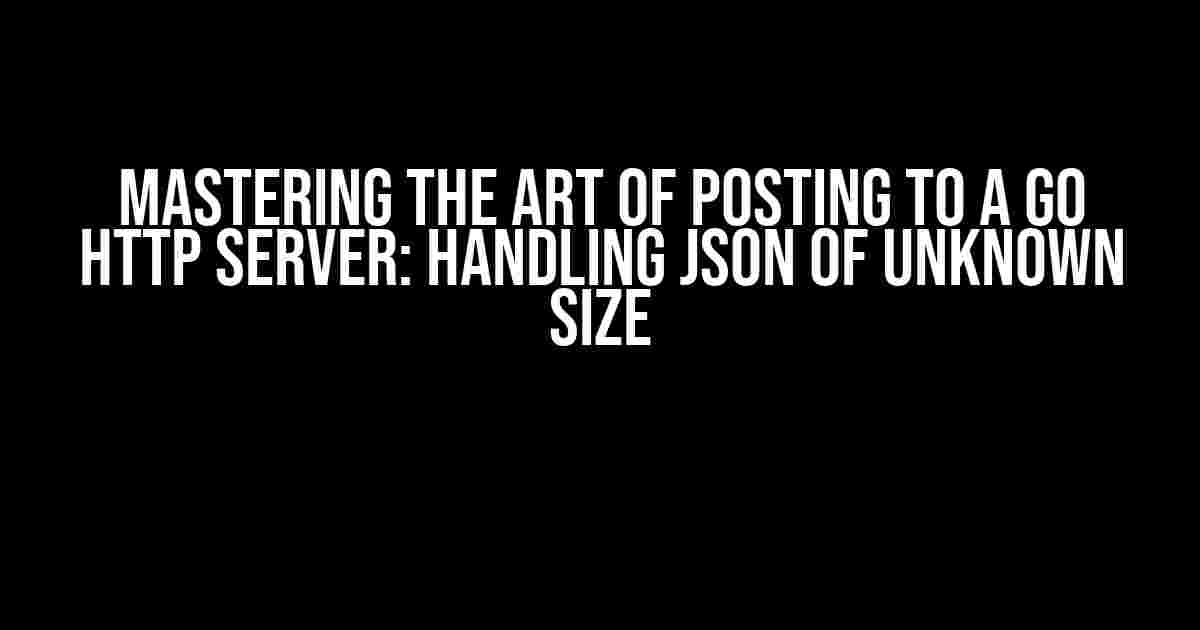Are you tired of dealing with pesky JSON size limitations when posting to a Go HTTP server? Do you find yourself constantly worrying about buffer overflows and awkwardly truncated data? Fear not, dear developer, for we’re about to embark on a journey to demystify the art of posting to a Go HTTP server, sans size constraints!
- Understanding the Problem: The Perils of Unknown JSON Size
- The Solution: Streaming JSON Data to the Rescue!
- Get Your Go On: Creating a Streaming JSON Encoder
- The Streaming Magic: Sending JSON Data in Chunks
- Handling Errors and Interruptions
- Conclusion: Mastering the Art of Posting to a Go HTTP Server
Understanding the Problem: The Perils of Unknown JSON Size
We’ve all been there – crafting the perfect API, only to realize that our JSON payload is limited by some arbitrary size constraint. But why does this happen? Well, it’s quite simple: most HTTP servers, including those written in Go, have a maximum allowed request body size to prevent abuse and denial-of-service attacks. This size limit is usually specified in bytes and can vary greatly depending on the server configuration.
So, What Happens When You Exceed the Limit?
The consequences of sending a JSON payload that exceeds the server’s limit can be dire. You might encounter:
- Truncated data: The server simply chops off the excess data, leaving you with an incomplete or corrupted payload.
- Buffer overflow errors: The server’s buffer overflows, causing the entire request to fail or, worse, crash the server.
- Request rejected: The server flat-out rejects the request, often with a 413 “Payload Too Large” status code.
The Solution: Streaming JSON Data to the Rescue!
So, how do we overcome this limitation? Enter streaming JSON data! By streaming the JSON payload in chunks, we can bypass the size constraint and ensure that our data reaches the server in its entirety.
Breaking Down the Streaming Process
To stream JSON data to a Go HTTP server, we’ll follow these steps:
- Create a JSON encoder that can stream data in chunks.
- Establish a connection to the Go HTTP server.
- Stream the JSON data to the server in chunks.
- Handle any errors or interruptions during transmission.
Get Your Go On: Creating a Streaming JSON Encoder
In Go, we’ll use the `encoding/json` package to create a streaming JSON encoder. We’ll create a custom `JSONStreamer` struct that will handle the chunking and encoding of our JSON data:
package main
import (
"encoding/json"
"io"
)
type JSONStreamer struct {
enc *json.Encoder
}
func NewJSONStreamer(w io.Writer) *JSONStreamer {
return &JSONStreamer{enc: json.NewEncoder(w)}
}
func (j *JSONStreamer) Encode(v interface{}) error {
return j.enc.Encode(v)
}
func (j *JSONStreamer) EncodeUnsafe(v interface{}) error {
return j.enc.Encode(v)
}
func (j *JSONStreamer) Flush() error {
return nil
}The Streaming Magic: Sending JSON Data in Chunks
Now that we have our `JSONStreamer` struct, let’s create a sample JSON payload and stream it to the Go HTTP server in chunks:
package main
import (
"fmt"
"net/http"
)
func main() {
// Create a sample JSON payload
payload := struct {
Name string
Age int
Hobby []string
}{
Name: "John Doe",
Age: 30,
Hobby: []string{"coding", "gaming", "reading"},
}
// Create a new HTTP client
client := &http.Client{}
// Establish a connection to the Go HTTP server
req, err := http.NewRequest("POST", "http://localhost:8080/api/endpoint", nil)
if err != nil {
fmt.Println(err)
return
}
// Create a JSONStreamer
streamer := NewJSONStreamer(req.Body)
// Chunk the JSON payload into smaller parts
chunks := [][]byte{
[]byte(`{"Name": "` + payload.Name + `"`),
[]byte(`, "Age": ` + fmt.Sprintf("%d", payload.Age)),
[]byte(`, "Hobby": [`),
}
for _, hobby := range payload.Hobby {
chunks = append(chunks, []byte(`"` + hobby + `"`))
}
chunks = append(chunks, []byte(`]}`))
// Stream the JSON data in chunks
for _, chunk := range chunks {
err := streamer.EncodeUnsafe(string(chunk))
if err != nil {
fmt.Println(err)
return
}
}
// Send the request
resp, err := client.Do(req)
if err != nil {
fmt.Println(err)
return
}
defer resp.Body.Close()
fmt.Println("Request sent successfully!")
}Handling Errors and Interruptions
While streaming JSON data, it’s essential to handle any errors or interruptions that may occur during transmission. This includes:
- Connection timeouts: The server might take too long to respond or close the connection abruptly.
- Buffer overflows: The server’s buffer might still overflow if the chunk size is too large.
- Encoding errors: JSON encoding errors can occur if the data is malformed or corrupted.
We can handle these errors using Go’s built-in error handling mechanisms, such as:
if err := streamer.EncodeUnsafe(string(chunk)); err != nil {
switch err {
case io.EOF:
fmt.Println("Connection closed unexpectedly")
case http.ErrBodyReadAfterClose:
fmt.Println("Buffer overflow detected")
default:
fmt.Println(err)
}
return
}Conclusion: Mastering the Art of Posting to a Go HTTP Server
And there you have it, folks! With this comprehensive guide, you should now be able to post JSON data of unknown size to a Go HTTP server without worrying about size constraints. By using a streaming JSON encoder and chunking the data, we can ensure that our payload reaches the server in its entirety, even if it exceeds the server’s buffer size limit.
| Keyword | Description |
|---|---|
| JSONStreamer | A custom struct for streaming JSON data in chunks |
| io.Writer | An interface for writing data to a stream |
| json.Encoder | Go’s built-in JSON encoder for encoding data |
| http.Client | Go’s built-in HTTP client for sending requests |
| http.Request | A structure representing an HTTP request |
Remember, when dealing with large JSON payloads, it’s crucial to be mindful of the server’s buffer size limit and the potential consequences of exceeding it. By using the techniques outlined in this article, you’ll be well-equipped to handle even the largest of JSON payloads with ease.
Happy coding, and don’t let JSON size constraints hold you back!
Frequently Asked Question
Get ready to unlock the secrets of posting to a GO HTTP server with JSON data of unknown size!
Q1: How do I handle JSON data of unknown size when posting to a GO HTTP server?
When dealing with JSON data of unknown size, use the `http.Request.Body` stream to read the request body in chunks. This approach allows you to process the data gradually, without having to load the entire JSON payload into memory. In GO, you can use the `json.Decoder` type to decode the JSON stream incrementally.
Q2: What is the best way to set the Content-Type header when posting JSON data to a GO HTTP server?
When posting JSON data, set the `Content-Type` header to `application/json` to indicate that the request body contains JSON data. This header is essential for informing the GO HTTP server how to parse the request body. You can set this header using the `http.Request.Header` map, like this: `req.Header.Set(“Content-Type”, “application/json”)`.
Q3: How do I handle large JSON payloads when posting to a GO HTTP server?
To handle large JSON payloads, consider using a streaming JSON parser like `encoding/json` in GO. This parser allows you to process the JSON data incrementally, without having to load the entire payload into memory. Additionally, consider setting a reasonable limit on the request body size to prevent abuse and denial-of-service attacks.
Q4: What are some common pitfalls to avoid when posting JSON data to a GO HTTP server?
Common pitfalls to avoid include not setting the `Content-Type` header, not handling errors and panics properly, and not validating user input data. Make sure to validate and sanitize user input data to prevent security vulnerabilities and ensure data consistency.
Q5: Are there any GO libraries that can help me with posting JSON data to a GO HTTP server?
Yes, there are several GO libraries that can help you with posting JSON data to a GO HTTP server. Some popular ones include `net/http`, `encoding/json`, and `github.com/gorilla/http`. These libraries provide convenient functions and data structures for working with HTTP requests and JSON data.





